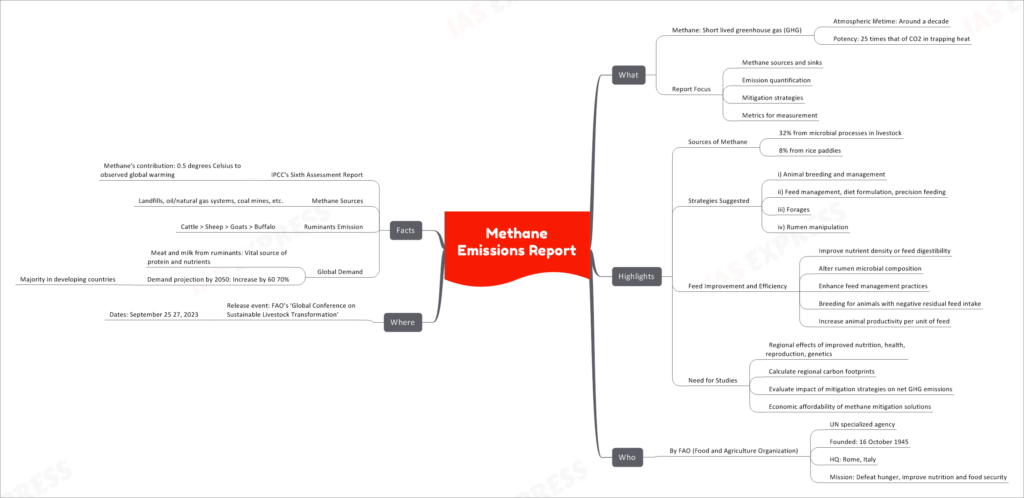Methane emissions in livestock and rice systems report

Methane, a short-lived greenhouse gas (GHG) with an atmospheric lifetime of around a decade, is known for its potency in trapping heat. In fact, it’s approximately 25 times more effective in this regard compared to carbon dioxide (CO2). The recent report by the Food and Agriculture Organization (FAO) delves into the critical issue of methane emissions in livestock and rice systems, addressing key aspects of its sources, quantification, mitigation, and measurement metrics.
This topic of “Methane emissions in livestock and rice systems report” is important from the perspective of the UPSC IAS Examination, which falls under General Studies Portion.
Insights from the Report
Sources of Methane
The report identifies the major sources of methane emissions:
- Microbial Processes in Livestock: Approximately 32% of methane emissions originate from microbial processes in the digestive systems of livestock.
- Rice Paddies: Rice paddies contribute about 8% of global methane emissions.
Suggested Mitigation Strategies
To combat methane emissions, the report suggests a range of strategies:
i) Animal Breeding and Management: Implementing improved breeding and management practices. ii) Feed Management and Diet Formulation: Optimizing diets and practicing precision feeding. iii) Forages: Promoting the use of specific forage crops. iv) Rumen Manipulation: Exploring methods to influence microbial processes in the rumen.
Feed Improvement and Efficiency
Enhancing feed efficiency and improving nutrient density are crucial components of mitigation strategies. These measures include:
- Improving the nutrient density or feed digestibility.
- Altering rumen microbial composition.
- Enhancing feed management practices.
- Breeding animals with negative residual feed intake.
- Increasing animal productivity per unit of feed.
The Need for Further Studies
The report highlights the importance of conducting studies to understand regional effects of improved nutrition, health, reproduction, and genetics. These studies are crucial for:
- Calculating regional carbon footprints.
- Evaluating the impact of mitigation strategies on net GHG emissions.
- Assessing the economic affordability of methane mitigation solutions.
The FAO: A Key Player in Global Food Security
The Food and Agriculture Organization (FAO), a specialized agency of the United Nations, was founded on October 16, 1945, and is headquartered in Rome, Italy. Its mission is to combat hunger, improve nutrition, and enhance food security worldwide.
Release Event at FAO’s ‘Global Conference on Sustainable Livestock Transformation’
The report was released during FAO’s ‘Global Conference on Sustainable Livestock Transformation,’ which took place from September 25-27, 2023.
Notable Facts
- The Intergovernmental Panel on Climate Change (IPCC) Sixth Assessment Report highlights that methane contributes 0.5 degrees Celsius to observed global warming.
- Apart from livestock and rice systems, methane emissions also originate from sources such as landfills, oil/natural gas systems, coal mines, and more.
- Among ruminant animals, cattle are the largest contributors to methane emissions, followed by sheep, goats, and buffalo.
- Globally, there is a rising demand for meat and milk from ruminants, as they provide essential protein and nutrients. By 2050, this demand is projected to increase by 60-70%, with the majority coming from developing countries.

